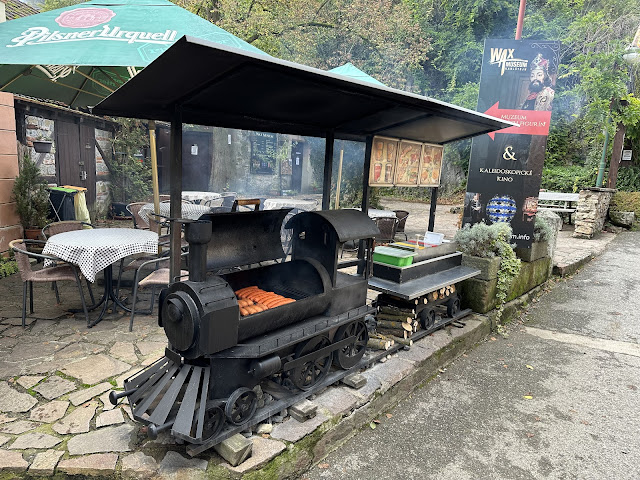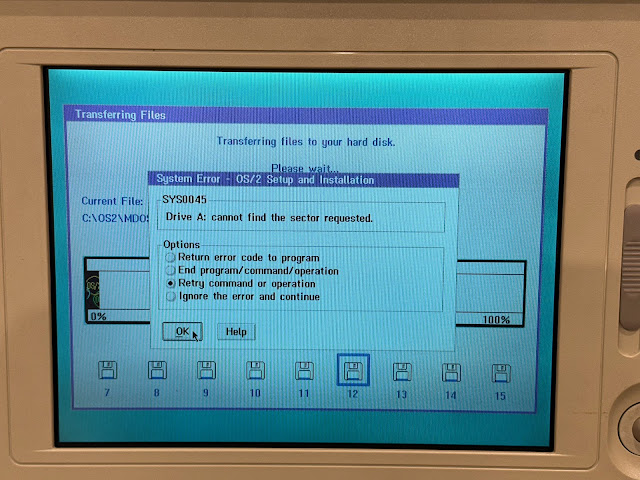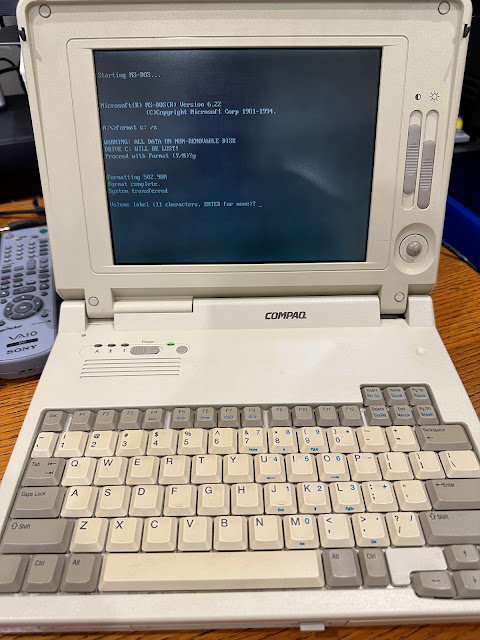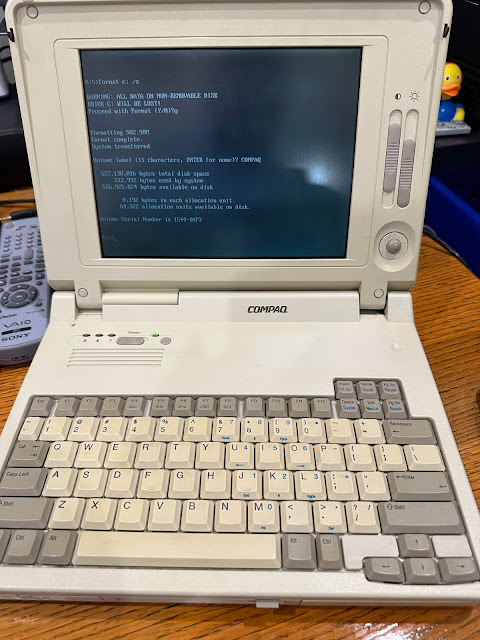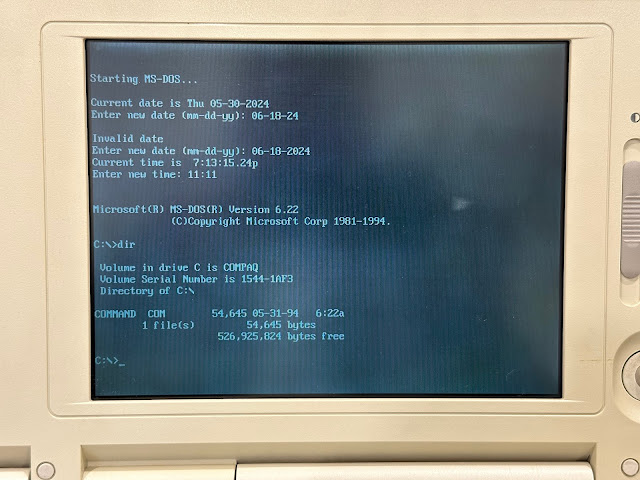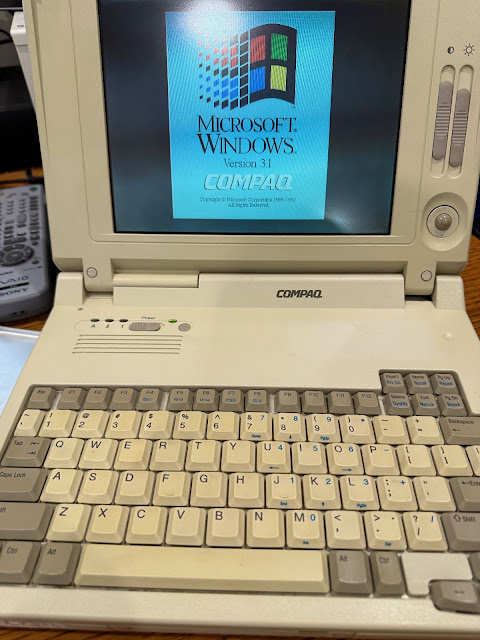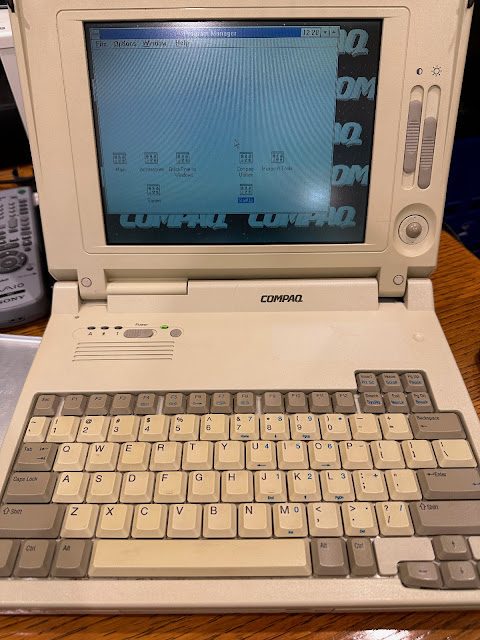Retro PC Builds in 2024 - Part 2
I had planned to do this next part much earlier, but I had to travel to Prague again for work in late September and much of October.
As an aside I did see an interesting train bbq on a walk to a local castle called Karlstejn on a weekend I had off while there - and what a cool idea for a train! I want it in the backyard of my house for bbq's in summer! :-)
Anyway, enough of my excuses - my apologies for the delay between posts.
Continuing on from Part 1, as promised I will look next at the build of the Compaq LTE Elite laptop I picked up this year.
I ran fdisk from a MS-DOS boot disk floppy and then blew away the OS/2 partitions and setup the IDE to CF drive as a single FAT16 hard disk.
I then downloaded a Compaq Windows 3.1 system image file from archive.org for this model of laptop. I mounted it on my Alienware Aurora PC, which runs Windows 11.
I then installed Win32s, which enables running (some) 32 bit applications under Windows 3.1:
Freecell is installed as part of this, which is a native 32 bit application, to show it works on the new installed Win32s.
I then set to work installing other Windows 3.1 applications, like Microsoft Video codecs, Windows Media Player, etc:
One limitation of the Compaq Elite laptop is sound - PC speaker only. Fortunately in recent years retro enthusiasts have solved this by developing OPL3 Ad-lib compatible sound chips accessible via the parallel port! I picked up the OPL3LPT to try it out on the Compaq laptop:
I downloaded the support files for OPL3LPT from Github, copied them to the CF card (which I removed and re-installed in the Compaq laptop), and then set to work:
With the command mentioned previously run with the card installed into the parallel port, the initialisation of the OPL3LPT works, and shows the device is ready:
I run the OPL2test command to make sure the sound and left/right channels works correctly - and it works great:
I added the adlipt init command into the autoexec.bat file so it will initialise on boot everytime. I also removed the command to run Windows automatically, so it finishes booting in MS-DOS.
This means I can test demos and games without the additional memory overhead of Windows 3.1. I tested with Commander Keen first, since I know it supports older ADLIB and Soundblaster cards. It works perfectly with the OPL3LPT.
I should mention that there is a MIDI parallel port audio device you can buy also, which I expect would help to bring the amazing Doom music to life more than an ADLIB device will...
Satisfied for now, I moved onto Windows 3.1, and added sound driver support into Windows too. This unfortunately I still needed to use the PC Speaker for.
I even installed Microsoft Arcade to enjoy some Windows 3.1 games besides the usual card games, Mine sweeper, etc:
The system arrived very dirty indeed from its previous owner. It needed a thorough cleaning before I could even start to use it:
Here is the view of the inside of the system - 3 PCI slots, no ISA and no AGP:
Lite-on CD drive is installed, and it sits behind the front door on the case - the tray opens without opening the front door:
Turning to the back of the system, the usual PS/2, parallel, serial, onboard VGA port, audio ports and joystick/MIDI port are present, along with 2 USB ports.
After a thorough cleaning, I turned my attention to the onboard VGA, which clearly would not be what I wanted for this machine. I wanted a 3DFX system, which with the absence of a AGP slot means I have to use a PCI based 3DFX solution.
Voodoo3 cards don't have a pass through like Voodoo 2 cards, as they include a 2D and 3D card in the same card.
I booted up the system, and the display worked through the Voodoo 3 card straight away, so I didn't need to change anything in the BIOS to use it.

I put this IBM Aptiva system next to my MSDOS and OS/2 Warp 4 installed Pentium 200MMX IBM 300GL - they looks nice together, and since they need to share the same PS/2 keyboard, mouse and screen using a switch box due to space constraints, that was another reason.
I didn't bother trying to setup Windows 2000, or install the Voodoo 3 Driver CD I also downloaded and burnt to CD, as I didn't plan to keep this operating system on it.
It then stopped and said the partition table was not acceptable, and I needed two use fdisk to delete the existing partition first.
Seems the recovery cd has no ability to prep the existing hard disk, even though it was the one the system originally shipped with.
I then rebooted and booted from the recovery cd again - this time it was happy to proceed with the recovery process:
On reboot, the system now started a new install of Windows 98, using the drivers and other software IBM included in the recovery image:
I forgot how OEM companies liked to add lots of rubbish software on their images, and IBM was no exception to this, with plenty of bloatware out of the box...
You would say I should have done a vanilla install, but I was too lazy to locate all the drivers...I did however need to install the Voodoo 3 drivers from the official CD image I got from archive.org and burnt earlier.
With the Voodoo 3 graphics drivers installed, I now had a true colour 1280x1024 Windows 98 desktop, and it looked great.
Next, I downloaded the firmware updates for the BIOS on the system, as the last firmware update IBM released for the system allowed it to use larger hard disk sizes above 64GB, which I hoped to take full advantage of later!

Actually, it was relatively uncommon to update firmware regularly in those days, but IBM did release a number of updates for their systems, which was great to see.
After the reboot, I went into the BIOS to confirm the new BIOS version - I guess this one is Y2K compliant since it is after 2000... :-)
With this done, I turned my attention to important matters - installing and running 3DFX games and demos.
Seeing the 3DFX splash screen again on the IBM Aptiva was so awesome - it has been long time since I saw it last, as the A4000T didn't have many games that used hardware 3D and the 3dfx screens didn't display on the Amiga even when I did play games that used the 3dfx 3d hardware.

I also tried out Windows 3dfx demos from my collection - I kept all my demos I downloaded from that era, so trying them out was easy:
This demo had a benchmarking tool included, and ultimately turned into 3D Mark series of benchmark software a few years after this demo.
I was still waiting for the CF to Ide adapter to arrive, which was getting seriously annoying as I wanted to make more progress with the hard disk setup.
Of course this meant running through the recovery disc process again. Since I intended to use a 32GB CF card, I decided to format only 30GB of the capacity at this point, to make it easier to transfer the data to a image file on my Alienware Windows 11 PC later on. I can then write it to the new CF card and put into the adapter when I get it.
I then booted from the IBM recovery Windows 98 SE CD and recovered it to the new 30GB drive, and then installed the 3DFX drivers again.
To make data transfers easier, I installed USB drivers for Windows 98 SE as these are not in the recovery cd for some reason.
This allowed me to then plug in USB drives to make larger data transfers much easier. I started installing 3dfx tools and updates, patches, and more.
With the Cd protection schemes used on this era CD's, they don't work on more modern computers without no-cd patches and other hacks. I want to keep the system pure and period correct, so I need to use the cd's to play the games.
I feel a twinge of local pride since this software is made in Australia by GP Soft - I met the Directory Opus authors at an Adelaide Retro computer event a few years ago.
Finally, the IDE to CF adapter arrived, and just in time as I really wanted to backup the physical hard disk before I put too much more software and configuration on it. This adapter comes with a bracket so I can mount it to a rear empty slot.
The adapter needs a floppy power connector from the PSU to power it. There is also a jumper next to it to choose if the drive is Master or Slave in the IDE chain.

Here is the CF to IDE adapter now installed in the IBM Aptiva - I used the bottom slot to keep the IDE cable as far from the Voodoo 3 card as possible since it gets quite warm when used for 3dfx gaming or demos:
Here is the view of the back of the IBM aptiva slots, showing the CF adapter at the bottom to allow for easy insertion and removal of the CF card, the Ethernet card above it, and the Voodoo 3 PCI card with VGA port above that.
Next step is the removal of the 30GB hard disk. IBM thoughtfully included a rotating pull function to easily seperate the hard disk/floppy drive cage from the rest of the system without having to remove the drives or screws.
I connected it to my USB to SATA/IDE converter, and supplied molex power from a power supply included with the USB converter.
I then could use Win32imager to capture the 30GB drive to a file on my Alienware PC under Windows 11.
With the image written out to the CF card, I then inserted it into the IBM Aptiva and went into the BIOS to make sure it was detected ok, which it was detected correctly based on the original source image size of 30GB.
The remaining capacity of the CF card is in effect wasted at this point, so using a 32GB CF card would have been better. However, I hadn't planned this delivery of the adapter to take so long and being keen to make progress was willing to use a lower sized physical drive to do it.
I got a little distracted at this point, as I got given an old parallel port 250MB zip drive from my brother. Actually, I never owned a parallel port zip drive, only SCSI ones.
But, it was free, I have lots of zip disks laying around, and this was the right era machine to use it in. So I connected it up.
I downloaded the Iomega driver cd iso from Archive.org and burnt it off - seriously, this website is so helpful for retro pc builders in 2024...I then started the installation:
As my Amiga uses SCSI 100MB zip drives with 100MB disks, that is all I have on hand to use with this 250MB drive. I understand this means performance is slower than if I used 250MB zip disks with it, but I use what I have.
I am pleased to say it worked first time. This particular zip disk's previous owner had classic racing cars photos stored on this disk from a book presumably - it has the author name, book title, ISBN number and publisher listed on the disk label.
Zip disks are bigger than floppy disks and so they had their own special zip disk containers you could get for them - luckily I have some of these.
Iomegaware CD has lots of applications on it, including a backup program for backing up your system to zip disk. Nice.
Iomegaware adds lots of functions to the context menus in Windows also, allowing easy formatting, disk protection, eject, disk copy and other functions:
The backup utility program works well too, backing up selections of files to zip disk, although the format used for the backups requires you to use the same program to restore later...
With the Zip drive working well, I moved onto the next thing I wanted to get working, a Sony Clie palm device which I picked up on Ebay from a local seller in Australia.
I have a long history setting up Palm PDA devices for work in the late 1990's and early 2000's with the original Palm Pilot Professional and later Tungsten T. I long wanted one of these Sony clie palm devices, which introduced some cool multimedia functions to the standard PalmOS offering on their own handhelds.
At the top there is a Memory stick slot and a CF card slot. The CF card is intended for the sony CF accessories like the WiFi CF card expansion, but there is a patch which "fixes" it so you can put in normal cf cards for additional storage too.

The sticking point is the tiny memory stick capacity - 128MB.
I put a couple of MP3's on it, but not many as I needed the space for applications and games I wanted to try also.
With the capacity limitations of memory stick, you definitely are not going to put all your mp3 collection on it - but you could put enough songs for a daily commute to work for example.
This was the biggest issue with the Palm devices. The storage limits. Even though bigger capacity memory stick and CF cards are available, these devices couldn't actually use them.
For internet ones I needed a keygen application also that generates the key to use based on the name you use to sync the Palm device via HotSync.
More modern games like Wordle are also available for Palm, so I had fun playing that during ad breaks on TV...
Video playback is limited to low resolution due to the processor power, but if you keep to the limitations it is fine. The main problem is space to store videos on the memory stick anyway.
Rotating the clie changes the screen layout to landscape - we expect that these days with iPhones and iPads, but back then it was not that common. For card games this is great:
I have to say, I really like the Sony Clie and wish I could have had one back in the day. These days the memory stick capacity limits it's usefulness.
Some applications didn't see the CF card storage either, which made it too flakey to use all the time - shame.

